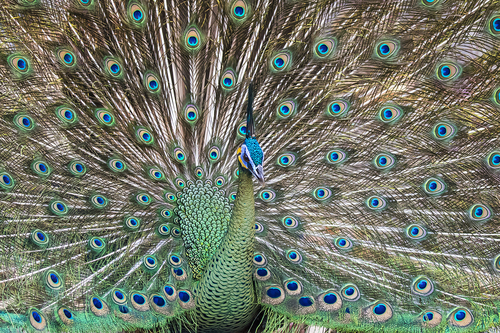
Green Peafowl
The Green Peafowl (Pavo muticus) is a stunning bird species renowned for its iridescent green plumage and elaborate courtship displays. Unlike its more common relative, the Indian Peafowl, the Green Peafowl is native to the forests of Southeast Asia. It plays a crucial role in its ecosystem as both a seed disperser and prey for larger predators. Culturally, it is featured in various regional folklore and art, often symbolizing beauty and royalty. However, due to habitat loss and hunting, it faces significant conservation challenges.
180-300 cm
Length
120-160 cm
Wingspan
Endangered
Conservation Status
Distribution
Historically found across Southeast Asia, from eastern India and Bangladesh to Java, Indonesia. Current populations are fragmented, with significant numbers in Myanmar, Thailand, parts of Indochina, and Java. They exhibit a wide altitudinal range, from lowlands to elevations of up to 2000 meters.
Lifespan
Up to 20 years in the wild, potentially longer in captivity.
Green Peafowl's Habitat
Habitat Types
Tropical and subtropical moist broadleaf forests, Dry deciduous forests, Bamboo forests, Forest edges near grasslands and cultivated areas
Climate Zones
Tropical, Subtropical
Adaptations
Their strong legs and feet are well-suited for terrestrial movement through dense undergrowth. Their coloration provides camouflage within the dappled light of the forest floor.
Variations
Three recognized subspecies exist: *P. m. muticus* (Java), *P. m. imperator* (Indochina), and *P. m. spicifer* (north-eastern India, Bangladesh and western Myanmar). These subspecies show variations in neck and breast coloration, as well as crest shape.
Appearance
Breeding Plumage
Males in breeding plumage have a spectacular elongated upper tail covert (the 'train'), which is shed after the breeding season. Non-breeding males have shorter tail coverts.
Seasonal Feather Changes
The train is grown and shed annually. Overall plumage brightness may also vary slightly.
Sex Based Plumage Differences
Males have the iridescent green train and a more metallic overall coloration. Females are predominantly brown and green, lacking the train, providing better camouflage for nesting.
Notable Features
Long, iridescent green train (males only), Upright, pointed crest on the head, Bare facial skin, blue and yellow around the eyes, Spurs on the legs of males, used in territorial disputes
Diet and Feeding
Primary Foods
Seeds, Fruits, Insects, Small reptiles, Amphibians, Invertebrates
Foraging Behavior
Forages on the ground, scratching and pecking at leaf litter and soil. Often found near water sources. They are typically seen foraging in the early morning and late afternoon.
Specializations
Strong legs and beak adapted for foraging on the forest floor.
Seasonal Diet Variations
Diet may shift depending on the availability of fruits and insects. During the dry season, they may rely more on seeds and grains.
Behavior
Social Structure
Generally solitary or found in small family groups. During the non-breeding season, larger groups may congregate near food sources.
Communication
Loud, resonant calls, particularly during the breeding season, Visual displays, including the fanning of the train, Rattling of the train feathers during courtship
Migration
Not typically migratory, but may make local movements in response to food availability or water sources.
Territorial or Group Behaviors
Males are territorial during the breeding season, defending areas where they display to females. Outside of breeding, they are less aggressive.
Conservation
Threats
Habitat loss and fragmentation due to agriculture and logging, Hunting for food and feathers, Poaching of eggs and chicks, Disturbance from human activities
Protection Programs
CITES Appendix II listing (regulates international trade), Protected areas within its range, Community-based conservation initiatives in some areas
Local National Laws
Protected under national wildlife laws in several countries within its range, including Thailand, Myanmar, and Indonesia.
Population Trend
Decreasing
Population Estimates
Estimated at 10,000-19,999 mature individuals, with ongoing declines.
Interesting Facts
The Green Peafowl's train can reach up to 1.5 meters in length.
This impressive display is used to attract females during courtship.
Unlike the Indian Peafowl, both male and female Green Peafowl have similar crests.
However, the male's crest is slightly more prominent.
Green Peafowl are capable of strong flight, despite their large size.
They often roost in trees at night to avoid predators.
Faqs about Green Peafowl
What is the difference between Green Peafowl and Indian Peafowl?
Green Peafowl have green and gold plumage, while Indian Peafowl have blue and green plumage. Green Peafowl males also have a more upright crest and different vocalizations.
Are Green Peafowl endangered?
Yes, the Green Peafowl is classified as Endangered by the IUCN due to habitat loss and hunting.
What do Green Peafowl eat?
They are omnivorous, feeding on seeds, fruits, insects, small reptiles, and amphibians.
Copyright @ Nature Style Limited. All Rights Reserved.
 English
English